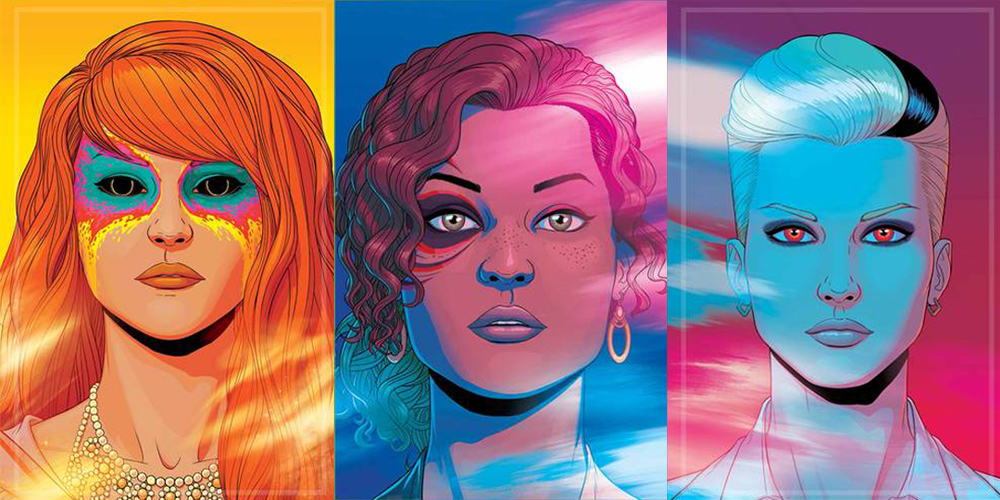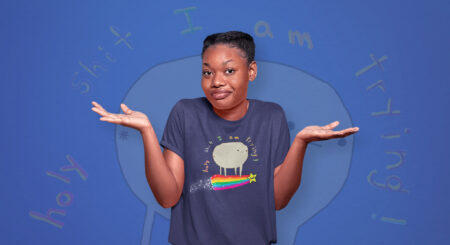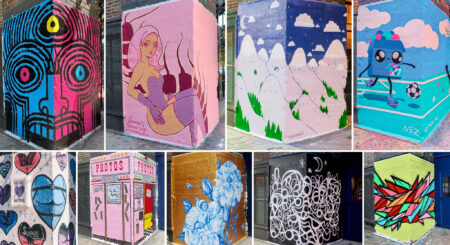If modern day legends like giants have since become Sasquatch, and the Kraken’s just been re-named Giant Squid, then our modern day Gods, demons, and deities? Those have become popstars.
That’s the idea behind The Wicked + The Divine – the Image comic created by Kieron Gillen and illustrated by Jamie McKelvie – which, as Gillen described it, “is basically about gods as popstars and popstars as gods.”
In The Wicked + The Divine (called WicDiv), every 90 years, 12 gods return to Earth as young people. They are loved & feared, become pop-culture sensations who gather and inspire huge crowds…and in a mortal twist, they all die in two years.
WicDiv is insanely meta; a commentary on pop-culture and the popstar effect while also existing as a pop-culture phenom in itself that fans love and cosplay as and create fanart for. So it’s extra-fitting that the WicDiv Artist Shop is made up almost entirely of shirts worn in the comic.
I had the pleasure of interviewing Kieron and Jamie about WicDiv‘s success, its beautifully diverse lineup of characters, and about their Artist Shop. Check out what they had to say!
. . .
Which gods or figures from myths and legends would you love to see embodied in the comic?
K: Well, ideally we’ll get to them all in time. When choosing the gods and popstars, there was a push and pull. Some of the characters, we knew the god first and had to work out what popstar archetype they’d be (Baal and Morrigan, for example). On others, we knew the popstar archetype and had to search for the god (The Welch/Bush/Nix, the Daft Punk, etc). Sometimes, we got both at once (Lucifer as gender switched David Bowie).
 But I did have a long, long list of gods that I was considering. I was playing with Mithras for a while. There was actually a Siberian god who all I could find details about was that he was a sky god and otherwise was basically unknown, and there was an appeal there.
But I did have a long, long list of gods that I was considering. I was playing with Mithras for a while. There was actually a Siberian god who all I could find details about was that he was a sky god and otherwise was basically unknown, and there was an appeal there.
My favourite fan theory was that Santa Claus was going to be one of the gods. Which would have been awesome.

Are the characters/plot points based on real celebrities, scandals, and all that good pop-culture stuff that people eat up?
K: Not in a 1:1 way, but everything goes in the mix. The gods themselves are basically archetypes of popstars, and normally drawing from many sources. Usually you can see some of the influences more than others, but it’s complicated. Take Amaterasu, for example, who is basically anyone who exists on the road between Kate Bush and Florence Welch.
The idea is mainly that they are versions of this archetype rather than anyone individually. Same as many of the plots – we’re hitting archetypal actions rather than any one specifically. As the central “everything returns” part of the plot suggests, we’re interested mainly in the constants in creative life.
The biggest influence is actually everything that happened to Jamie and I ever since we started on the road to being a creator. Our old book, Phonogram, was about being a consumer of art. WicDiv is about being a creator of it, and all the monsters we met along the way; including the ones in the mirror.
It feels oddly meta to be asking you this given that commentary, but how does it feel working on a comic that blows through the pop-culture smoke while simultaneously becoming a pop-culture item?
K: This is the sort of thing which makes us smile. It’s a book about pop cults which was explicitly designed with an eye on being a pop cult. People ask whether the book is a critique or a celebration, which is a response to our ambivalence to that. It’s both. And if it’s a critique of pop cults, it’s by definition a critique of itself.

We do play games with it a lot – many of our T-shirts are actually garments that have actually appeared in the comic, worn by fans in the comic. So you can buy them, and cosplay as a fan as seen in WicDiv, to show that you’re a fan of WicDiv. This strikes us as fun.

K: Image offers you many things, but the main one is that it’s almost complete creative control. I’m sure that there’s something we could do which Image would say no to, but in a real way, we give them a PDF of the issue and (bar editorial oversight) they print it. We have an editor, but she’s our editor (i.e. she works for us, rather than for Image.)
There are disadvantages to it – the support of a more traditional publisher is a huge boon in many other ways – but for a project where you need to have absolute control (like WicDiv) it’s an unparalleled experience. I doubt we could do what we do with WicDiv anywhere else.

With stories like WicDiv, I think it’s easy to fall into the red/black=hellish, white/gold=heavenly stereotypical color scheme. Your unique art style and color sets WicDiv apart and makes it its own thing. How did you go about developing the look of the comic from a color aspect?
J: Well I can’t really claim any credit for the colour, as that’s down to our incredible colourist Matt Wilson. But we spent a lot of time setting the tone for the book in the early days. We wanted it to look glam, like a music video. Matt had the idea of turning up the lights when a god uses their powers, like a live gig. In terms of colour schemes for each god, it varies. Sometimes it was in line with the popstar archetypes they were embodying, sometimes it was the god, sometimes it was a bit of both.
WicDiv has some stunning character design – What is your creative process for designing the settings and characters? Is there any particular character that was the most rewarding or challenging to create?
J: We spent a lot of time before the book began pulling together inspiration on a secret tumblr (now wicdivstyleblog.tumblr.com), adding images from music and fashion that could feed into the look of what we wanted to do. Then it was a case of looking at the personality and history of each character and deciding where to pull influence from. As Kieron mentions, some are closer to a single point of origin than others, but they all become their own person in the drawing and telling of the story. I might do some head sketches, but I generally design on the page. It all sits in my head and it’s often something of a needless step to spend time on separate character designs when I can just get into the business of drawing pages. The original portrait covers were also kind of character designs, in that way.
I read that after David Bowie passed away, people were posting pictures of “Luci” in his honor – what was it like to see that?
K: It was humbling. We’re obviously both enormous Bowie fans. I actually wrote a short piece of fiction afterwards, with Luci paying homage to Bowie. He was a giant.
One of the things I really love about WicDiv is its diversity in gender, race, and LGBTQ representation. Is this character range a commentary in itself about the need to grow diversity in mainstream media?
K: We basically wanted to do a book that looked and felt like London, the city we live in and the city we love. And…well, I actually have enormous sympathy for the old superhero universes. The DC universe basically had its foundations laid in the 1930s. Marvel had its laid in the 1960s. Both are times with very different ideas of what diversity meant…and those characters are still around, and still taking up roles.
The thing with a fictional universe is that you basically need each character to have a niche. You can’t just make the paragon of superheroic strength a black gay guy in the DCU, as that job is already filled by Superman. It’s basically a Baby Boomer problem, made worse by the fact he’s never going to retire. The creators there do a lot of work, but there are so many limitations they can’t avoid.
Conversely, if you’re making an entirely new creation in 2014, everything is up for grabs. We’ve got no excuse. This comes back to your earlier question about creative control – we can do whatever we want, so we will. In actual fact, Jamie and I get a bit twitchy when people are so kind about the diversity in the book, because we basically consider what we do the bare minimum. That the bare minimum is actually considered in any way worthy of praise is as depressing as anything else, y’know?

I know what you mean – I wish diversity in stories was the norm rather than news-worthy. Given that, what’s the most rewarding part of seeing such a multi-leveled and inclusive story taking off?
K: Every day gives us something magical. I just turned on the Internet this morning and had three pieces of amazing fan art pop up on my tumblr. We go to cons and see dozens of people dressed as our characters. We get mail from people who have been profoundly moved and changed by the book.

It’s…something we used to say when starting Phonogram was that Jamie and I were the sort of people who were transformed by the art we consumed. Our aim was to create work which did the same for other people. With WicDiv, we’re aware that we may have pulled that off, and it’s both humbling and absolutely petrifying.

A big part of WicDiv seems to be struggling with identity and yourself vs how people view you – what’s been the response to this aspect of the comic?
K: Identity versus appearance is one of the big themes in our work, I suspect. During the Commercial Suicide arc, when we had guest artists drawing the book, Jamie was drawing our final Phonogram, The Immaterial Girl. That was 100% about the wrestling of image versus identity, and it runs through WicDiv as well.
As it’s such a constant, it’s actually hard to separate response out to the aspect. It’s just there, and must resonate with people, as otherwise you’d presume they’d stop reading our books.
The title “The Wicked + The Divine,” the juxtaposition between gods and humans, the line between everyday human being and popstar royalty – WicDiv has a lot of juxtaposition in it – what, to you, is this comic really about?
K: Imagine me smiling here.
I’ve got a standard brief explanation of its core themes, which are built right into its concept. It doesn’t matter if it’s 2 years, or 10 years or 70 years. We’ve all got an incredibly brief span of time on this planet. Why do anything? Relevantly, why be an artist. The shortening to two years makes the question sharper, but it’s still true for all of us. It’s about a variety of creative peoples’ response to that unavoidable looming existential horror. Each of the gods have their own take, and through juxtaposition you can hopefully get a more complete picture. You’re right that juxtaposition is one of our go-to techniques, and is especially to the fore in WicDiv, probably in a way which it hasn’t been since Phonogram: The Singles Club.
But that’s the relatively easy stuff, the stuff we felt we had to front load – because the flip of having a diverse cast is that this is a book where the cast are all going to die, and readers need to be okay with that before going in. The other themes bubble up, and we point towards them. I mean, there isn’t “Good and Evil,” but “Wicked and Divine,” which is a significantly different thing.
Generally speaking, I prefer people to work it out by themselves. WicDiv is certainly designed to bring attention to what it’s about. There are certain themes which are pretty pronounced by around issue 11 or so. There’s at least one big theme which I suspect will only be entirely clear as we approach the end. It’s a story where we know the whole structure of the thing, and it’s all leaning towards that final denouement.
Piggybacking off of that answer, the comic has this note of, “art can be a wonderful thing, and can also be a self-destructive thing.” Why do YOU do art? What’s your advice to other artists?
J: I mean, I do art because I don’t really know how to do anything else, and I love telling stories. Comics are about telling stories. A book can look incredibly beautiful, but if the storytelling is poor, and I can’t tell what is happening, or who is talking, or where the characters are, then it’s of no use to me. So my advice is focus on telling the story – the rest will come. Also, get exercise and make sure you take breaks! You don’t want to end up like me with lots of back problems caused by years of working too long, and having to spend a lot of effort to undo issues I could have avoided to start with.
Last question…I definitely wrote these questions while listening to “Don’t Fear the Reaper” to get in the zone. Are there any songs you listen to while working on WicDiv?
K: Hah. There’s a playlist I’ve built for writing WicDiv too. It’s presently approaching 350 songs.
J: I’m always listening to music. In the mornings I listen to my friend Lauren’s radio show on 6Music – she plays a big variety, both new and old. And then in the afternoons and evenings, whatever I’m into at that moment. Right now it’s the new Minor Victories and Tegan and Sara albums.












